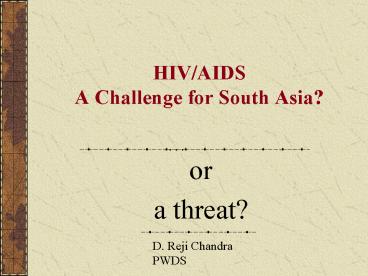HIVAIDS A Challenge for South Asia - PowerPoint PPT Presentation
1 / 18
Title:
HIVAIDS A Challenge for South Asia
Description:
As of December 2002, an estimated 42 million people were living with HIV/AIDS ... 'Our continent did not have to be devastated. ... – PowerPoint PPT presentation
Number of Views:25
Avg rating:3.0/5.0
Title: HIVAIDS A Challenge for South Asia
1
HIV/AIDSA Challenge for South Asia?
- or
- a threat?
D. Reji Chandra PWDS
2
A threat because the numbers are alarming
As of December 2002, an estimated 42 million
people were living with HIV/AIDS (95 in
developing countries). These include 3.2 million
children under fifteen years of age and 19.2
million women. There were an estimated 7.2
million people living with HIV/AIDS in South Asia
and the Pacific in December 2002.
3
A threat based on the African experience If it
can happen in Africa, if unchecked, it can repeat
in Asia
Our continent did not have to be devastated. We
should not have allowed HIV/AIDS to get to this
stage and we have a responsibility to reverse the
situation, a person living with HIV/AIDS stated
in the African Development Forum consultation.
Perhaps this is the strongest message we in
Asia have to draw on Act Before Calamity (ABC).
4
A threat created by HIV orphan crisis
HIV/AIDS is leaving a generation of orphans in
its wake. This crisis brings even greater
urgency to the already desperate situation of
children. 14 million children (12 million
African) lost one or both parents due to
HIV/AIDS. It is projected that the global number
of AIDS orphans may reach 40 million before 2010.
5
A threat because
- Prevalence among low risk groups or
- general population.
- Youth in productive group affected.
- Additional burden on already existing
- poverty-related diseases.
- Taboo attached to sex and sexuality.
- Powerlessness of women in sex-related
- decisions.
- Commercial interests of pharma companies.
6
A threat because current interventions
- Focus mostly on urban areas and high
- risk groups.
- More on prevention with approaches
- that cause stigma
- Isolated interventions from a health
- service delivery approach.
7
- Parallel services instead of mainstreaming
- and strengthening existing services.
- Prioritising HIV affected families in the
- context of poverty.
- Interventions failing to reach rural areas
- women.
- Poor health care services and negative
- attitude towards infected.
- Lack of comprehensive and integrated
- approach - poverty related issues.
8
Poverty issues matters
Poverty
Income and Food insecurity
Risk of infection HIV infection to AIDS
Malnutrition Risky survival strategies
9
The community matters
Children
Mother
Family
Community
Services
Care givers
10
The economic condition matters
Health
Nutrition
Psycho-social needs
Needs are inter-related
Education
Policies
11
Vulnerability and Dependency
- Poverty and vulnerability are the key and
interrelated factors. Strengthening community
capacity and reducing vulnerability are
important. - Impact of HIV/AIDS increases the dependency of
vulnerable (countries) on developed nations.
12
The questions are Why is Africa first and so
high in prevalence? Why does Asia seem to be
next? Why is it a threat in undeveloped areas
and not in developed pockets ? Poverty/lack of
development seems to be the only valid answer.
13
Perceptions regarding the disease have changed
from whispered asides to one that is a global
health agenda in fact it has turned out to be a
global development agenda.
14
A development agenda Community capacities
- HIV is a threat, but while addressing in the
beginning/stabilised stage, it needs to be
perceived as a development opportunity. - HIV responses need to be planned as empowering
interventions for strengthening community
capacities orienting (women) on sex sexuality
issues, body literacy, and health care.
15
Strengthening services
- Strengthening existing health care services and
influencing health policies and priorities for
making (government) services work for the poor. - Improving health seeking behaviour and access
to services.
16
The Challenge
Capacity to see the larger issues related to
HIV/AIDS like poverty, inadequate (health)
services, and constraining policies.
To aim at greater development impact, that is
sustainable, through HIV/AIDS interventions.
The real challenge is Learning to see beyond
HIV/AIDS through HIV/AIDS.
17
A Human Resource Crisis
18
It is true as Dr. Piot says, If you dont
survive, you cannot develop. But we should
also understand the truth that If you dont
develop, you cannot survive.






























